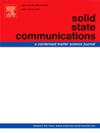Comparative study of electronic and optical properties of monolayer MoSi2N4 with adsorbed functional groups
IF 2.1
4区 物理与天体物理
Q3 PHYSICS, CONDENSED MATTER
引用次数: 0
Abstract
The electronic and optical properties of monolayer MoSi2N4, modified by the adsorption of eight distinct functional groups—hydrogen, halogens (fluorine, chlorine, bromine, iodine), oxygen, hydroxyl, and amino—were systematically explored using first-principles simulations. The adsorption coverage was varied (n = 1–16), revealing profound modifications in the electronic structure, particularly when all silicon or nitrogen atoms on a single surface were fully functionalized (16 adsorbed atoms). Notably, the bandgap diminished to 0 eV upon adsorption of hydrogen (H), fluorine (F), or iodine (I), while chlorine (Cl) and bromine (Br) adsorption reduced the bandgap from 1.79 eV (pristine MoSi2N4) to 0.92 eV (MoSi2N4-Cl16) and 1.12 eV (MoSi2N4-Br16), respectively. In contrast, oxygen (O), hydroxyl (OH), and amino (NH2) groups resulted in bandgaps of 1.25 eV (MoSi2N4-O16), 1.19 eV (MoSi2N4-OH16), and 1.05 eV (MoSi2N4-NH216). A comparative analysis of the optical absorption spectra demonstrated that surface adsorption significantly broadened the absorption range, extending it into the infrared region while encompassing the ultraviolet and visible domains. Among the functional groups studied, iodine adsorption induced the most pronounced enhancement in the absorption intensity. Following the adsorption of 16 iodine atoms, the maximum ultraviolet absorption coefficient reached 1.07 × 105 cm−1, more than doubling the intrinsic value. These results highlight the efficacy of functional group adsorption in tuning the optoelectronic properties of MoSi2N4, with H, F, and I atoms exerting the most substantial influence on the bandgap and iodine atoms exhibiting the most significant and tunable optical absorption characteristics.
具有吸附官能团的单层MoSi2N4的电子和光学性质的比较研究
利用第一性原理模拟系统地探索了通过吸附八种不同官能团(氢、卤素(氟、氯、溴、碘)、氧、羟基和氨基)修饰的单层MoSi2N4的电子和光学性质。吸附覆盖范围是不同的(n = 1-16),揭示了电子结构的深刻变化,特别是当单个表面上的所有硅或氮原子被完全功能化时(16个吸附原子)。值得注意的是,吸附氢(H)、氟(F)或碘(I)后,带隙减小到0 eV,而氯(Cl)和溴(Br)的带隙分别从1.79 eV(原始MoSi2N4)减小到0.92 eV (MoSi2N4- cl16)和1.12 eV (MoSi2N4- br16)。相比之下,氧(O)、羟基(OH)和氨基(NH2)基团的带隙分别为1.25 eV (MoSi2N4-O16)、1.19 eV (MoSi2N4-OH16)和1.05 eV (MoSi2N4-NH216)。光学吸收光谱的对比分析表明,表面吸附显着拓宽了吸收范围,将其扩展到红外区域,同时涵盖了紫外和可见光域。在所研究的官能团中,碘吸附引起的吸收强度增强最为明显。吸附16个碘原子后,最大紫外吸收系数达到1.07 × 105 cm−1,是本征值的两倍多。这些结果突出了官能团吸附在调整MoSi2N4光电性能方面的有效性,其中H, F和I原子对带隙的影响最大,而碘原子表现出最显著和可调谐的光学吸收特性。
本文章由计算机程序翻译,如有差异,请以英文原文为准。
求助全文
约1分钟内获得全文
求助全文
来源期刊

Solid State Communications
物理-物理:凝聚态物理
CiteScore
3.40
自引率
4.80%
发文量
287
审稿时长
51 days
期刊介绍:
Solid State Communications is an international medium for the publication of short communications and original research articles on significant developments in condensed matter science, giving scientists immediate access to important, recently completed work. The journal publishes original experimental and theoretical research on the physical and chemical properties of solids and other condensed systems and also on their preparation. The submission of manuscripts reporting research on the basic physics of materials science and devices, as well as of state-of-the-art microstructures and nanostructures, is encouraged.
A coherent quantitative treatment emphasizing new physics is expected rather than a simple accumulation of experimental data. Consistent with these aims, the short communications should be kept concise and short, usually not longer than six printed pages. The number of figures and tables should also be kept to a minimum. Solid State Communications now also welcomes original research articles without length restrictions.
The Fast-Track section of Solid State Communications is the venue for very rapid publication of short communications on significant developments in condensed matter science. The goal is to offer the broad condensed matter community quick and immediate access to publish recently completed papers in research areas that are rapidly evolving and in which there are developments with great potential impact.
 求助内容:
求助内容: 应助结果提醒方式:
应助结果提醒方式:


